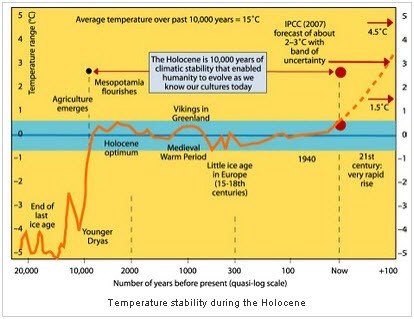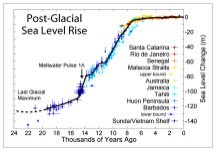When James Hansen talks climate change, people listen. The head of climate studies at NASA, Hansen first gave evidence on the issue to the US Congress in 1988, and is now an eminent scientist and a prominent public advocate.
In new research just out, Hansen concludes that at the current temperature, no “cushion” is left to avoid dangerous climate change, and that the Australian government target goals “… of limiting human-made warming to 2° and CO2 to 450 ppm are prescriptions for disaster”.
The question Hansen raises is direct and brutal in its implications: is the planet already entering a zone of dangerous climate change?
With Arctic sea-ice in a “death spiral”, Greenland in 2010 melting at an unprecedented rate, a seemingly extraordinary number of extreme climate events in the past year from the Russian fires to the Pakistan floods, and 18 countries setting temperature records, have we already gone too far for a safe climate?
In a draft of a new research paper, Hansen and his collaborator Makiko Sato has opened a new debate about what might be the conditions for a safe climate; that is, one in which people and nations can continue to live where and as they have been, with secure food production, and in a bio-diverse environment.

The period of human settlement over the past 10,000 years is known as the Holocene, during which time temperatures and hence sea levels (the two having a close correspondence) have been remarkable stable. Temperatures over the period have not been more than 0.5C warmer or cooler than the mid-line (see chart). The warmest part of the Holocene (the “Holocene maximum”) was about 8000 years ago, and according to Hansen, today’s temperature is about, or slightly above, the Holocene maximum:
“… we conclude that, with the global surface warming of 0.7C between 1880 and 2000, global temperature in year 2000 had returned, at least, to approximately the Holocene maximum.”
Note, this is to the year 2000, and temperatures have increased ~0.15C in the last decade, so:
“Global temperature increased 0.5C in the past three decades to a level comparable to the prior Holocene maximum, or a few tenths of a degree higher.”

That is, we are already a little above the Holocene maximum. This matters because Hansen’s and Sato’s look at climate history (paleoclimatology) in this new research finds that it is around this temperature level that the large polar ice sheets start to behave differently. During the Holocene, the Greenland and Antarctic ice sheets have been relatively stable, as reflected in the stability of the sea level. But once substantial melting starts, the loss of heat-reflecting white sea-ice, which is replaced by heat-absorbing dark ocean water, produces an “albedo flip”:
“Summer melting on lower reaches of the ice sheets and on ice shelves introduces the “albedo flip” mechanism. This phase change of water causes a powerful local feedback, which, together with moderate global warming, can substantially increase the length of the melt season. Such increased summer melting has an immediate local temperature effect, and it also will affect sea level.”
Their conclusion is that:
“… the stability of sea level during the Holocene is a consequence of the fact that global temperature remained just below the level required to initiate the ‘albedo flip’ mechanism on Greenland and West Antarctica.”
The implication is clear that “just above” the Holocene maximum lurks real danger. As Hansen and Sato say:
“… the world today is on the verge of a level of global warming for which the equilibrium surface air temperature response on the ice sheets will exceed the global mean temperature increase by much more than a factor of two.”
That is, warming at the poles will become more rapid and exceed the ratio so far, of being twice then global average. This change, they say, can be found in past warming events such as the Pliocene about 3 million years ago, so that:
“… even small global warming above the level of the Holocene begins to generate a disproportionate warming on the Antarctic and Greenland ice sheets. “
To put it bluntly, we are on the edge of a precipice in terms of large ice-sheet losses and sea-level rises, and there is little “cushion” left:
“Polar warmth in prior inter-glacials and the Pliocene does not imply that a significant cushion remains between today’s climate and dangerous warming, rather that Earth today is poised to experience strong amplifying polar feedbacks in response to moderate additional warming.”
Sea-levels are one devastating metric of “dangerous climate change”:
“Sea level rise potentially sets a low limit on the dangerous level of global warming. Civilisation developed during a time of unusual sea level stability. Much of the world’s population and infrastructure is located near current sea level.”
While some suggest a linear (or flat line) increase in sea-levels this century, Hansen and Sato argue forcefully that:
“… the fundamental issue is linearity versus non-linearity. Hansen argues that amplifying feedbacks make ice-sheet disintegration necessarily highly non-linear. In a non-linear problem, the most relevant number for projecting sea level rise is the doubling time for the rate of mass loss. Hansen suggested that a 10-year doubling time was plausible, pointing out that such a doubling time from a base of 1 mm per year ice sheet contribution to sea level in the decade 2005-2015 would lead to a cumulative 5-metre sea-level rise by 2095. “
Here Hansen repeats his view, first published in 2007 but widely ignored, that a 5-metre sea-level rise is possible. In fact, recent research by Blancon et al published in Nature in 2009, examining the paleoclimate record, shows sea-level rises of 3 metres in 50 years due to the rapid melting of ice sheets 123,000 years ago in the Eemian, when the energy imbalance in the climate system was less than that to which we are now subjecting the planet.
So what evidence do we have of Hansen’s and Sato view that sea-level rises will be non-linear?
“The most reliable indication of the imminence of multimetre sea level rise may be provided by empirical evaluation of the doubling time for ice sheet mass loss. “
Looking at recent research on mass loss in Greenland and Antarctica:
“These data records are too short to provide a reliable evaluation of the doubling time, but, such as they are, they yield a best fit doubling time for annual mass loss of 5-6 years for both Greenland and Antarctica, consistent with the approximate doubling of annual mass loss in the period 2003-2008. There is substantial variation among alternative analyses of the gravity field data, but all analyses have an increasing mass loss with time, providing at least a tentative indication that long-term ice loss mass will be non-linear… We conclude that available data for the ice sheet mass change are consistent with our expectation of a non-linear response, but the data record is too short and uncertain to allow quantitative assessment. The opportunity for assessment will rapidly improve in coming years if high-precision gravity measurements are continued.
Further evidence of our lack of “cushion” can be found by looking at the warm Eemian inter-glacial peak 125,000 years ago, when it is generally understood that:
“… temperatures in the Eemian … were less than 1C warmer than peak Holocene global temperature”
In fact, Hansen and Sato conclude that:
“… global temperature was only slightly higher in the Eemian and Holsteinian interglacial periods than in the Holocene, at most by about 1°C, but probably by only several tenths of a degree Celsius.
Yet at these times:
“… some paleodata suggest rates of sea-level rise perhaps as high as 1.6 ± 0.8 metres per century and sea level about 4-6 metres above present-day values.”
A look at the Pliocene, three-to-five million years ago, leads to the conclusion that:
“… in the early Pliocene, when sea level was about 25 metre higher than today, was only about 1C warmer than peak Holocene temperature.”
While atmospheric CO2 amount in the Pliocene is poorly known, a typical assumption, based on a variety of imprecise proxies, is 380 ppm, or less than today’s level!!
So at today’s level of carbon dioxide, and not much above the current temperature, the world has experienced sea-levels five to 25 metres higher than at present! From that, it is not hard to understand why Hansen and Sato conclude that:
“… goals of limiting human-made warming to 2C and CO2 to 450 ppm are prescriptions for disaster.”
Summing up:
“Earth at peak Holocene temperature is poised such that additional warming instigates large amplifying high-latitude feedbacks. Mechanisms on the verge of being instigated include loss of Arctic sea ice, shrinkage of the Greenland ice sheet, loss of Antarctic ice shelves, and shrinkage of the Antarctic ice sheets. These are not runaway feedbacks, but together they strongly amplify the impacts in polar regions of a positive (warming) climate forcing … Augmentation of peak Holocene temperature by even 1C would be sufficient to trigger powerful amplifying polar feedbacks, leading to a planet at least as warm as in the Eemian and Holsteinian periods, making ice sheet disintegration and large sea level rise inevitable.”
In a line:
“Earth today is poised to experience strong amplifying polar feedbacks in response to moderate additional warming.”
We are perhaps already a few tenths of a degree above the Holocene maximum, and the system seems to be in the early stages of rapid change. It is widely expected Arctic sea-ice will be totally lost in summer with a few years to a decade or so, perhaps at less than 1C or warming. Very few scientists think Greenland would be stable in an Arctic with little or no summer sea-ice, and opinion is split as to whether it is past its tipping point already.
It is hard to argue that anything above the Holocene maximum (of about 0.5 degrees above the pre-industrial temperature) can preserve a safe climate, and that we have already gone too far. The notion that 1.5C is a safe target is out the window, and even 1 degree looks like an unacceptably high risk.
*This first appeared on Climate Code Red.







Yep, we’re screwed……but, hang on a minute, that graph you published has an altered time scale.
Maybe there’s still hope.
What we need is a shrill chorus of denial to tell is all one big lie (nazi reference apparently intentional).
Help us climate denialists, you’re our only hope……
CRAP CRAP and more CRAP.
Cue deniar trolls….
but Lorry, you’re a truck, a road vehicle, a cabin with wheels powered by an internal combustion engine! Of course you would think climate change is crap!
Thanks David Spratt for a sensible, worthwhile article about the most important challenge facing us – one that my children will have to deal with, and for which my grandchildren will probably despise people like poor, misguided ‘Lorry’.